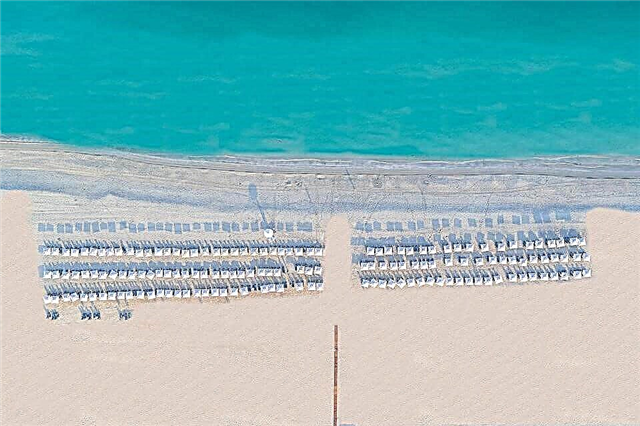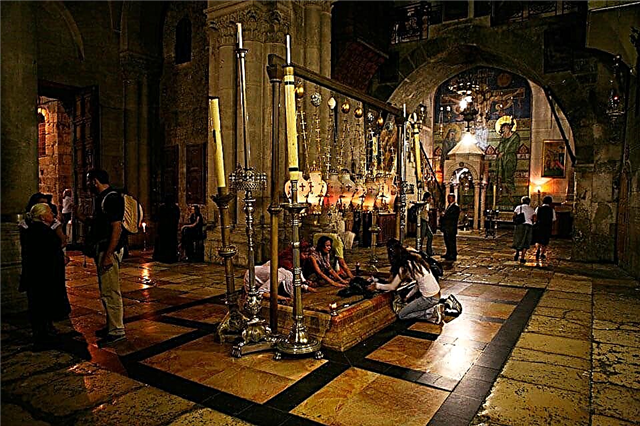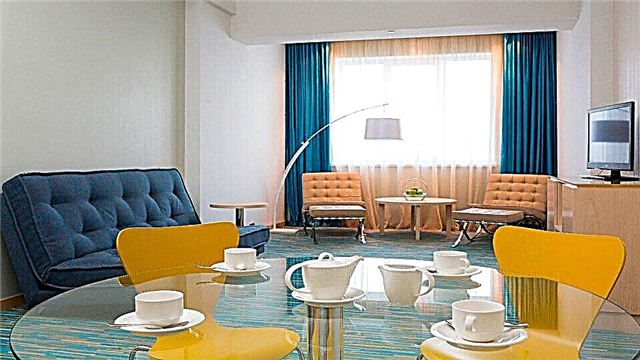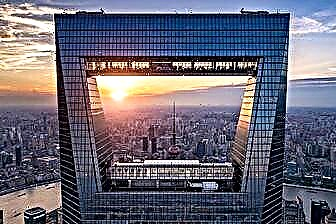Shanghai is a huge metropolis in which neighboring districts are often completely different from each other. Such a variety is a godsend for tourists: in one trip you can learn a lot of new and unusual things. The city is constantly changing, building on tradition. Therefore, lovers of antiquities and fans of progress will find it exciting.
The Huangpu River divides the city into two parts. The Pudong region, located on its eastern coast, is developing faster than others, as it has a special status. The tallest skyscrapers are concentrated here. Excursion ships sail along the river, observation platforms are open on high-rise buildings.
The old parts of the city are rich in Chinese flavor: museums with historical and cultural exhibits, avenues with architectural monuments and shopping streets, where markets and boutiques are located side by side.

The best hotels and hotels at affordable prices.
from 500 rubles / day
What to see and where to go in Shanghai?
The most interesting and beautiful places for walking. Photos and a short description.
Pudong New District
Located on the east coast of Huangpu. Received the status of a special economic zone in 1990. This allowed him to develop at an accelerated pace. In just a few years, new impressive skyscrapers have grown here. Divided into 4 sectors: financial, export, customs, high technology. Representative offices of many foreign companies are also located here.

Bund Bund
Passes along the banks of the Huangpu. The length is one and a half thousand meters. Its main feature is its exceptional architectural diversity. 52 buildings from the existing ones belong to different styles and time periods. Representatives of many foreign countries had a hand in their construction. Among the buildings there is the "Russian Bank" dated 1901. On the other side of the river, the Pudong Free Zone begins.

Nanshi old town
Modern Shanghai began its development from this place. Narrow streets, buildings of the 15th century, part of the defensive wall have been preserved here. In the very center there is a traditional Asian bazaar and shops for every budget. Among other things, you can buy antiques. The best time to visit is Chinese New Year. Sightseeing: Tea house, City of God temple, pagodas.

Yu Yuan Garden
It has been spread over the old districts of Shanghai since the 16th century. The translation of the name is "garden of joy". The area is about 4 hectares. The classic landscape design suffered during the colonial wars and uprisings. Renovated in 1956. The garden is divided into 6 sectors, very different from each other. There are ponds, flower beds, bridges, galleries and shops. Since 1982, it has been classified as a protected cultural monument in China.

Zhujiajiao ancient city
It is located near Lake Dianshanhu in the western suburbs of Shanghai. It is also called the city on the water. Thirty-six stone bridges have been thrown across numerous canals. They have names, and each has an interesting real story or legend associated with it. Some streets are only accessible by boat. Hiring a boat is not difficult - there are a lot of offers, you can also take with a guide who will lead the excursion.

French Quarter
Occupies the area around Huaihai Zhonglu Street and Jinjiang Hotel. At the beginning of the 20th century, the French Concession was located here. Since then, houses and mansions have been rebuilt into shops and residential complexes, but for the most part they have retained their facades. Suitable for leisurely walks, centenary plane trees grow around. It is believed that it was in this quarter that the Chinese Communist Party was born.

Tianzifang District
Among domestic tourists it was named "Chinese Arbat". The area is quite old and contains the homes of the poor and beautiful restored buildings. The intersecting streets are filled with merchants and shops. You can get around here on foot or by bike. There are snack spots and traditional Chinese snacks are sold everywhere. Large restaurants and art workshops are also open.

Nanjing street
One of the busiest streets in the world. Shanghai's main shopping street. Although it existed before, it began to take shape in its present form from the first half of the 20th century. Then the excitement began with the construction of 8 large department stores at once. Now there are about 600 shops on the street. Elite boutiques are located in the western part. The length is about 5 km, of which about 1.2 km is an exclusively pedestrian zone.

"Oriental Pearl"
The TV tower was opened in 1994. Height - 468 meters. One of the highest in Asia. The name is explained by the architectural features: 15 different-sized pearl spheres are located at different levels. Inside, there are two observation platforms with a glass floor: at a height of 263 and 360 meters. For convenience, there are 6 elevators. They can accommodate 30 to 50 people and take passengers from the first floor to the last in 40 seconds.

Shanghai tower
Built in Pudong area by 2015. The number of floors is 130, the height is 632 meters, the area is 380 thousand square meters. The tallest building in China and the third largest in the world. It is highlighted in the dark. It has an interesting shape, as if twisting in a spiral up to the roof. Nearby are the equally imposing Shanghai World Financial Center and Jin Mao Tower.

Shanghai World Financial Center
The construction was completed in 2008. The work dragged on for a decade due to the global financial crisis. The number of floors is 101, the height with the roof is 492 meters. Due to its unusual shape, it received the popular name "bottle opener". The building is able to withstand an earthquake up to 7 points. On every 12th floor there are special areas in case of fires, where people can take refuge before the arrival of the rescuers.

Jin mao tower
Construction began in 1994 and was completed 4 years later. American architects led by Adrian Smith were responsible for the project. The architecture is dominated by classical elements with the addition of the Gothic style. Height with a spire - 421 meters. The number of floors is 88, of which more than 30 are occupied by a status hotel. On the top floor there is an observation deck for excursion groups.

Shanghai Museum
People's Square is located in the city center. Significant entertainment events take place here, and government offices and cultural centers are concentrated around. One of them is the Shanghai Museum. Its goal is to preserve ancient Chinese culture and bring its principles to the people. The exposition is distributed over 11 galleries and 3 exhibition halls. The building is square with a round dome. It symbolizes earth and sky.

Museum of Jewish Refugees
Located in Hongkou area. During the Second World War, Shanghai received about 25 thousand Jewish refugees who fled from the persecution of the Nazis from different countries. The capital of China has officially granted them asylum, unlike a number of other states. The museum building is the former Ohel Moshe synagogue. The exposition consists of documentary evidence, personal belongings of displaced persons, archival photos.

Shanghai History Museum
Foundation year - 1983. The funds contain 30 thousand exhibits. In 2001, the museum temporarily moved to the first floor of the "Eastern Pearl". Now located in the Shanghai Race Club building. The exposition tells about the ancient stages of history, about the life of the townspeople, the construction of ports, foreign settlers, the preserved traditions of Shanghai. Particularly valuable items: a huge jade screen, an ancient bronze cannon, "Flowers, insects and fish" embroidery.

Shanghai Natural History Museum
Founded in 1956. He occupied the premises of the Chinese cotton exchange. In 2015, it was moved to a purpose-built building in the sculpture park. The funds include 240 thousand storage units.The museum is one of the largest in the world in its thematic category. The collection consists of specimens of plants and animals, artifacts from the Stone Age, mineral deposits and even mummies.

Art museum of china
Started as the Shanghai Art Museum in 1956. It was expanded and changed its name in 2012. The exposition was moved to the pavilion built for the EXPO 2010. The exhibitions reflect all stages of the creative path of the artists of the Celestial Empire. Retrospectives are held not only of famous masters, but of those who have not yet made a name for themselves. Also exhibited are classic paintings of past centuries.

Propaganda Poster Art Center
A small private museum that has existed since 1995. The owner collects propaganda and patriotic posters from different periods. There are especially many posters in his collection from the times of the Cultural Revolution. The museum is located in the French Quarter, which is no coincidence: the first communist cells were born here. The exposition is located in two basement halls of an apartment building.

Shanghai Auto Museum
It has been receiving visitors since 2007. The first museum of this kind in China. The exhibition area occupies about 1.2 hectares. The exposition is divided into 3 pavilions according to sub-themes: history, vintage cars, research in the field of the automotive industry. The number of retro cars in perfect condition in the museum's collection has already approached 50 pieces. A total of 20 manufacturers are represented here.

Shanghai Urban Planning Exhibition Center
Located on the People's Square. The exposition is dedicated to the development of the city, the history of its development and changes to the existing look. Thanks to photographs and layouts, you can compare the current views of the city and how it looked in the past. There are also interactive tours of virtual streets. Each floor has its own theme. For example, the 3rd floor is almost completely occupied by the impressive size of the layout of Shanghai.

Temple of the Jade Buddha
Founded in 1882. The most visited Buddhist temple in the city. The main value is two statues made from solid pieces of jade. Their color is not the usual emerald, but light and delicate. About 70 monks live within the walls of the monastery. The height of the seated Buddha is just under 2 meters. It is richly decorated. The reclining Buddha is half as low and adorned with jewels. The temple houses the Shanghai Institute of Buddhism.

Temple of Confucius
It has been known since 1294. However, it was rebuilt and restored, especially after the battles of government troops and rebels in the middle of the 19th century. It has existed in its current form since 1995. The only temple associated with Confucius in Shanghai. The complex hosts all kinds of events, from exhibitions to book fairs. Attracts tourists during religious holidays.

Longhuasa Buddhist Temple
The most famous temple in Shanghai. Occupies an area of over 20 thousand square meters. Built in the 3rd century, but was destroyed. In 977 it was restored and a pagoda 40 meters high was erected. It was restored in the middle of the last century. In the halls of the Heavenly Kings, the Three Sages, the Abbot, Maitreya, the Great Sage, themed statues are installed. The Tripitaka House was also built here, where the Chinese Buddhist canon is kept.

Jing'an
The temple and monastery complex was founded in the 3rd century on the coast of the Suzhouhe River. In 1216 it was moved to its current location. Another large-scale restructuring took place in the 1880s. The complex includes 6 temples: Heavenly Kings, Jade Buddha, Good Deeds, Three Saints, Great Conqueror and Guanyin. The abbot's chambers were also built on the territory, stone statues and a bronze bell were installed.

Shanghai Oceanarium
Opened in 2002. All aquatic inhabitants, one way or another connected with China, live here. In addition, the main theme of the aquarium is the acquaintance with the underwater world of all continents. In total, there are 28 zones here. Each has a special system, depending on the conditions that the inhabitants need. For example, polar regions or sea depths are shown separately.

Shanghai Circus World
The Shanghai Circus is considered one of the best in China. Its program is varied and includes different directions. There are 2 arenas: an acrobatic and one for animals. Installed modern sound and lighting equipment to give, including performances using illusion. Themed events and exhibitions are held on the territory of the Circus World.

Happy Valley Amusement Park
Opened in 2009. It is located outside of Shanghai and is a very colorful place. There is a lot of greenery around, among which there are entertainment for every taste. There are also typical roller coasters and water adventures. The entrance ticket is a pass to all the attractions at once. Restrictions on certain attractions only in terms of height and age - for the safety of vacationers.

Disneyland
Opened in 2016. In mainland China, it is the first amusement park associated with the film industry. Covers an area of 390 hectares in the Pudong area. Divided into thematic zones, like all other Disneylands in the world. There is an avenue where parades are held, there is a shopping area with numerous shops. Popular attractions: Dumbo the elephant carousel, Treasure Cove, Toy Story adventure.

Shanghai maglev
The fastest commercial maglev rail line opened in 2004. It stretches between Longyang Lu Subway Station and Pudong Airport. Thanks to the developed speed of up to 431 km / h, it covers 30 km in less than 8 minutes. There are projects to extend the road to other important urban facilities and even to other cities, but so far they are unprofitable: the network is already suffering losses.

Huangpu river
The longest crossing Shanghai. Length - about 97 km, width on average - 400 meters. It divides the city into two parts: the Pudong area is located on the east coast, and the Puxi area on the west. The river is important for tourism, as cruise ships sail along it with sightseeing tours. They last from 30 minutes to several hours. Also, its waters are used for the household needs of the population.












